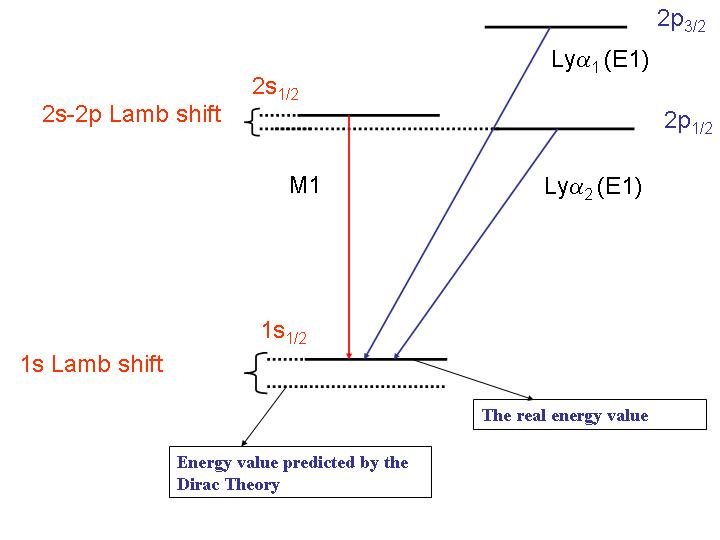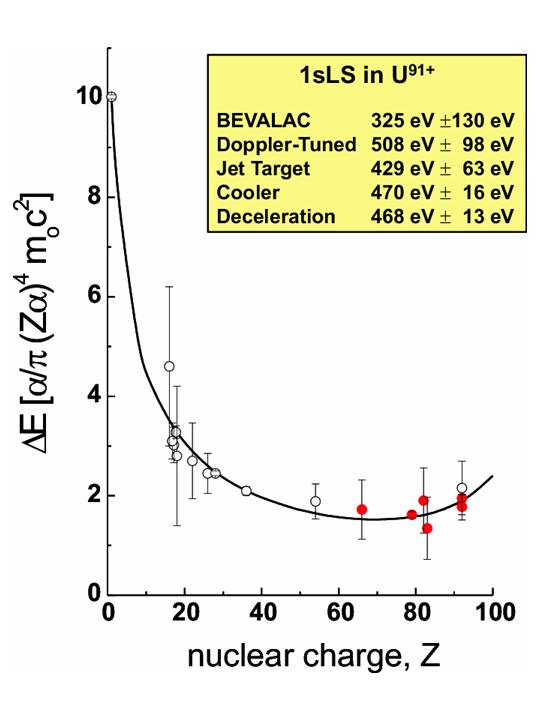Precision Tests of Strong Field QED
At the heavy-ion storage ring ESR, the effects of quantum electrodynamics (QED) can be studied even for hydrogenlike high-Z ions. In the strong fields of high-Z systems, higher-order QED effects can be investigated which are not accessible for low-Z ions. The goal of the experiments is to probe these higher-order QED contributions and to provide a stringent test of bound state QED.

For high-Z hydrogen-like ions, the most direct experimental approach for the investigation of the effects of quantum electrodynamics in strong Coulomb fields is a precise determination of the x-ray energies emitted by transitions from bound (and/or continuum) states into the ground state of the ion. In particular, the Lyman transitions (see figure above) are used in this kind of experiments as they appear most intense and well resolved in the x-ray spectra. The goal of the experiments is to achieve a precision which probes QED contributions which are beyond the one-photon exchange corrections. For the case of uranium where the total 1s Lambs shift contributes approximately 460 eV to the total ground state binding energy of 131.814 keV, such a stringent test of QED in strong field requires an absolute experimental accuracy of about 1 eV.

!!!! In the figure above the experimental results for the ground state Lamb shift in hydrogen-like ions are given and compared with the theoretical predictions (solid line). !!!! outdated? For comparison, the data shown in the figure are given in units of the function F(Zα). The solid symbols depict results from the SIS/ESR facility. Over the whole range of nuclear charges an excellent overall agreement between experiment and theory is observed. For the regime of the high-Z ions (Z > 54) most of the results provide a test of the ground-state Lamb shift contribution at the level of 30%. Only the results from the gasjet target (for uranium) and from the electron cooler (for gold and uranium) have a considerably higher accuracy. Up to now most of the Lamb shift experiments for high-Z ions were performed for hydrogen-like uranium.
In addition to one-electron systems, the study of spectra of helium-like ions has proven to be important for our understanding of relativistic, correlation and QED effects in many-body systems. Recently, there has been a significant progress in theoretical as well as experimental studies of such systems, in particular for the high-Z regime. Experimentally, the progress achieved manifests itself by a novel approach where the two-electron contributions to the binding energy in He-like ions can be experimentally isolated. This technique exploits the x-ray transitions from the continuum into the vacant K-shell of bare and H-like high-Z ions in order to measure the ionization potentials of He-like species with respect to that of the H-like ions which gives exactly the two-electron contribution to the ionization potential in He-like ions (see figure below). This technique was first exploited at the (superEBIT) in Livermore where the two-electron contribution to the ground state binding energy in helium-like systems was measured for various nuclear charges.

!!!! Very recently, we started our study of the two-electron contributions to the ground state binding energy in helium-like uranium in an experiment conducted at the electron cooler of the ESR storage ring. The aim of our present experimental study is to measure precisely the two-electron contribution to the ionization potential in He-like uranium of about 2.2 keV with an accuracy better than 5 eV. Since two-electron QED effects are calculated to contribute 7 eV, such an experimental study would therefore provide the first test of higher-order QED corrections (higher order in α) for a domain of high-Z ions. !!!! outdated?
Related Experiments:
Lamb Shift Measurements at the ESR Electron Cooler
The FOCAL Project
